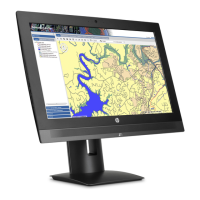RAID hard drive maximum and associated storage controller
options
This section lists the maximum number of hard drives supported on HP workstations according to RAID
conguration and storage controller options.
NOTE: This section applies to internal workstation congurations that do not use add-in cards and external
enclosures.
●
Maximum of two 2.5 inch hard drives
●
Two M.2 slots
Supported RAID congurations
The following RAID congurations are supported:
RAID conguration details
Conguration Description Controllers
RAID 0
Integrated striped disk
array
●
Requires a minimum of two drives.
●
Provides improved I/O performance.
●
Provides no fault tolerance.
●
Loses all data if any disk in the array fails.
●
Increases disk performance.
Intel with RST
RAID 1
Mirrored disk array
●
Supports a minimum of two drives.
●
Provides 100% redundancy: all data from one drive
is duplicated on a second drive.
●
Recovers from a single-drive failure.
●
Serves as a good entry-level redundant system.
Intel with RST
Conguring Intel SATA RAID
This section describes how to use Intel
®
Rapid Storage Technology (RST) to set up and manage SATA RAID
volumes.
NOTE: These instructions apply to Windows-based systems.
You can create a RAID array from two 2.5" drives attached to SATA ports, and/or two M.2 SSDs connected to M.
2 slots. RAID cannot be created across controllers, so 2.5" SATA drives cannot be congured with M.2 SSDs.
RAID must be enabled (Advanced > System Options > Congure Storage Controller for RAID is selected) to
set up any RST RAID.
When the Option ROM Launch Policy is set to All Legacy, the Intel SATA option ROM conguration utility runs
during POST if two SATA drives are attached. If only one drive is attached, the Intel option ROM conguration
utility does not run unless the drive contains RAID metadata indicating a failed RAID condition. Legacy Option
ROM cannot be used to congure RAID for M.2 SSDs.
76 Appendix B Conguring RAID devices

